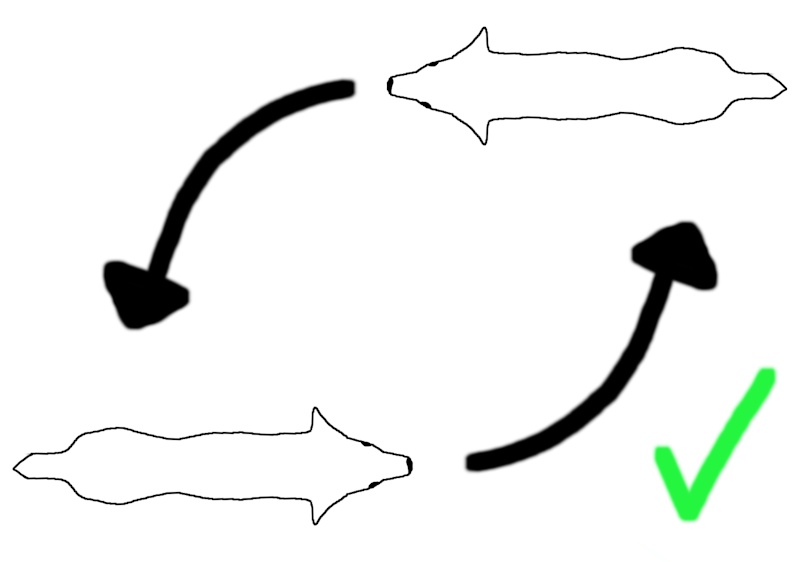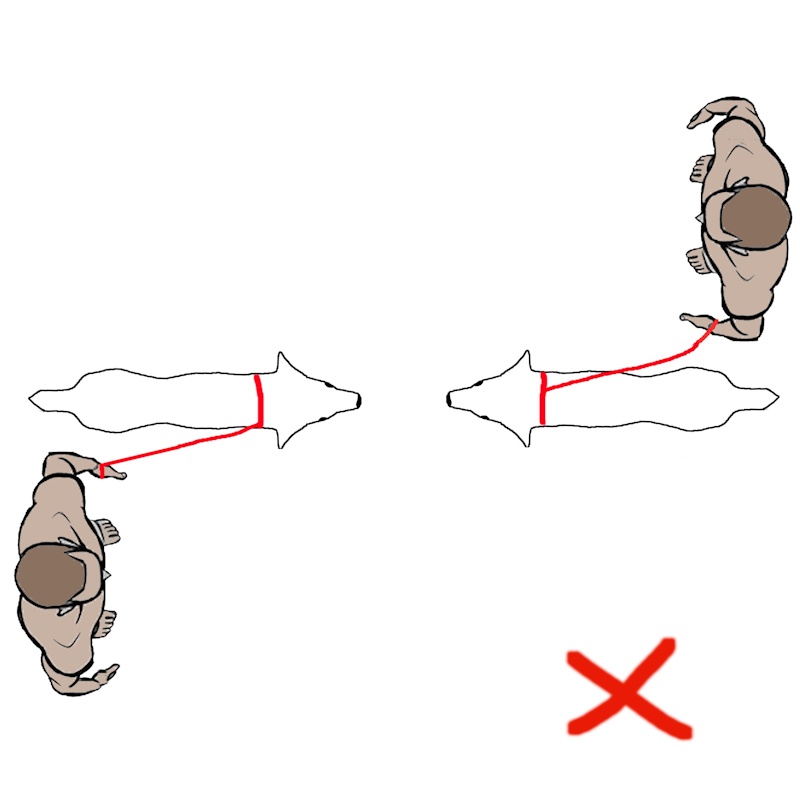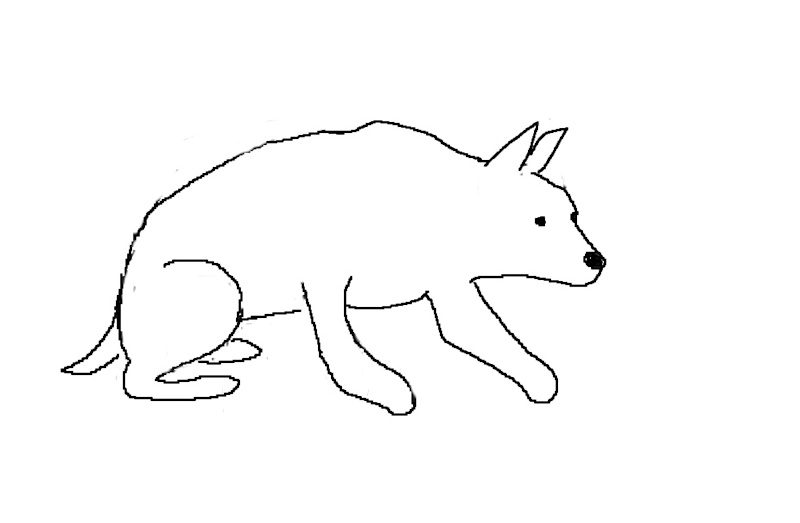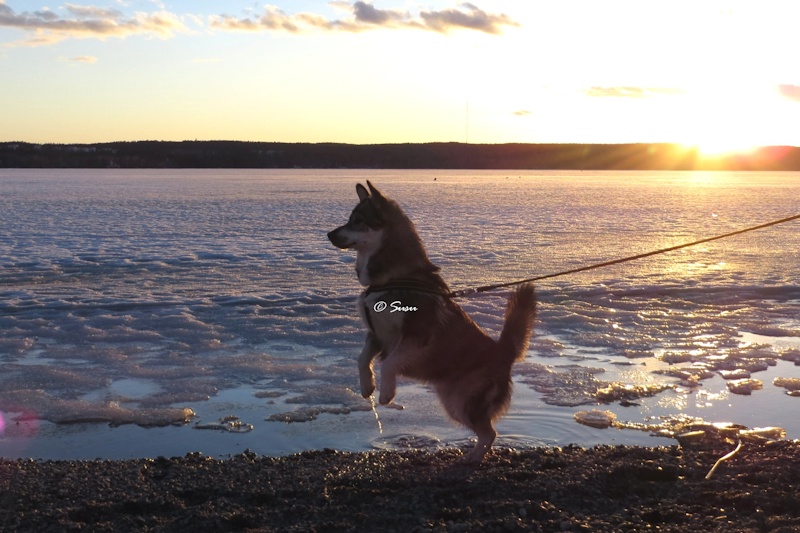Passing other dogs, cyclists or small children is difficult for many dogs and here are some tips how to make it easier.
I mainly focus here on how to pass other dogs, but you can apply same techniques for passing cyclists, skate boarders, small children or something else.
Remember that your dog is always mirroring your feelings. If you’re afraid when you and your dog are passing other dogs and if you assume that your dog is going to lunge and bark, then he probably will. If you are relaxed and trust your dog, he’s going to cope better because he senses your trust.
You may also want to read this related blog post: Are reactive dogs just highly sensitive?
Dogs never walk straight towards each other
When two dogs meet naturally, they don’t ever walk straight towards each other. They approach each other curving from the side. Walking straight towards means attacking in dog language.

When people walk their dogs on narrow sidewalks, many walk their dog straight towards other dogs without realizing that they are indicating to their dog to attack.
There are dogs that know how to be polite and pass other dogs that are walking straight towards. This knowledge doesn’t comfort those people who have reactive dogs and every passing is a nightmare.
First aid is to switch across the road so the dogs don’t face each other. If crossing road is not possible at a time, other alternative is to make a U-turn and select a different route.
You should always pass unfamiliar dogs so that the dogs are on the edges of the walkway and the humans are in the middle, between the dogs. Your dog should walk beside you, not in front of you. And always wait that the passers are at least 15 feet behind you before you let your dog to sniff their side of the walkway again. Never let your dog to go straight behind the passing dogs.
Miki has learned to pass normal calm dogs on the same side of the road. Unfortunately otherwise successfull passings often go south when the on comers let their dogs to go straight behind Miki. Miki thinks that the dog is attacking him from behind (although they’re just sniffing) and attacks back.
Here are drawings that shows the right way to pass other dogs, and two wrong ways that may not end well.



What causes the lunging, barking and growling
Brawling is due to more than just unintentional walking straight towards.
It may have begun gradually without the human even noticing. The dog may have been insecure or afraid of some other dog or something else (like wind or thunder or anything) and somehow connected it to other dogs. Alternatively the walker may have been insecure or afraid of something and the dog have thought that the walker is afraid of the on coming dog.
At that moment the dog has likely shown various body language signals to the walker to get out of the situation but the walker haven’t noticed it. The only way now is to banish the on comers by any means necessary, which is shown as growling, lunging, barking, showing teeth etc.
The dog has now learned, that brawling is the way to banish the on comers. That is true because at some point they will pass you and they move away. Dogs behave this way because they think it’s the right and the only way.
Dogs body language
Dogs communicate mainly with body language. You can read more about body language from these blog posts: Dog body language - calming signals and Dog body language: tail - a dog’s state of mind.
Dogs use body language to communicate with other dogs, but they also use it to communicate with humans as well. It’s very important to learn at least the basics of dog body language so you can read your dog but on coming dogs as well. Your dog will ALWAYS tell you his opinion of the on comers and it’s your responsibility to understand it.
If your dog’s behaviour doesn’t change at all (and you are sure about it) then it’s likely to pass other dogs successfully.
If your dog is a brawler, don’t force him into situations that he don’t know how to deal with.
Signs of danger
If your dog licks his chops or his nose, slows his pace, freezes, stares or stalks - these are the signs of danger. Your dog is now in the defend mode and he will defend himself and/or you when the on comers get close enough.
In the past Miki has shown all of these signs, but those situations require quick actions and therefore I don’t have any photos to show you.
In the drawing below, the dog has significantly slowed his pace. He has lowered his posture and he is stalking while still walking. His ears point forward and he has a hard stare. This is the last warning before it’s too late. From this point on there’s nothing you can do to avoid the lunge. The best thing is to move further away as quickly as possible.

In the next drawing you can see a dog, that has slowed down his pace so much that he has stopped completely. It may seem that he is just lying on the ground, but actually he is like a coiled spring ready to lunge at any moment. He has a hard stare and his head is way in front of his front paws. At this point the dog is not able to hear his walker anymore. The only thing he’s focused in is the attack itself.

Learn to read the smaller gestures so your dog can tell you (you understand when he tells you) he’s uncomfortable and you can exit the situation before it escalates.
If you notice this kind of behaviour in the on coming dog, for the sake of your own dog, don’t try to pass them because your own dog might get hurt.
For clarification below is a picture of a dog that is play bowing. Play bow is a friendly well meaning gesture and should never be confused with stalking. In play bow only a dog’s front is lowered and his rear stays up. His front paws are in front and his head is further back. Also his ears are back.

Another state of mind to watch out for is agitation. On coming dog may be in this state of mind for what ever reason, but your dog only sees the agitation and will probably react to it.
If either your dog or an oncoming dog is agitated or growling or lunging or showing teeth, do not try to go pass. For every one’s safety it’s best to give some space for a dog like this and pass them from a distance (like other side of the road).
You know a dog is agitated when he’s standing tall, his head is up, his ears are up and may point forward and his tail will probably be up too.
In the photo below you can see Miki is very agitated, because he has seen a dog he can’t stand. His head is up, his tail and ears are up (and point forward) and in addition he stands with his rear legs only. Oh boy..

Your body language
Dogs read human body language all the time. If you are tense or nervous or you pull your dog’s leash tight, your dog will notice it. Now your dog may attack the on comers just to protect you, because he thinks that you are afraid of them. Actually you may only be afraid of your dogs reaction to them, not the on comers.
Keep your posture but be relaxed when you walk your dog. Make sure the leash isn’t tight at any moment, even though you should hold onto it firmly. If the leash get tight you know you are too close when you pass other dogs.
Teach your dog how to pass
Your dog won’t ever learn how to pass other dogs if you don’t teach him a new way.
If you shout ja scold your dog when he’s acting bad, you will only make things worse. Shouting may even seem to your dog that you are trying to banish the on comers together. Okay then, let’s bark and growl even more because my owner is doing the same thing with me.
Pulling the leash is also a bad thing to do. It’ll cause pain in a dog’s throat and neck and then the dog will associate other dogs to pain and his owner being mad at him.
It’s important to understand that you need to chance your dog’s perspective and attitude to other dogs to more positive.
Now when your dog sees another dog, he might think: “help, I’m scared, I’ll brawl and he goes away”
New scenario might be something like this: “yes, an on coming dog, I know that by following my owner the dog will go away and by following her she gives me tasty treats”
Positive association
You can modify your dog’s association towards other dogs to be more positive. You need to connect the thing he scares to something he really enjoys.
Every time you see other dogs on your walks, give your dog some treats or toys or what ever he prefers if he stays calm. The only way to success is to be far enough - your dog is able to see the other dog but he’s so far away that he isn’t scared at all.
Sometimes things go south, but don’t punish your dog. Don’t reward or pity him either. Just move on.
Pay attention to your dog’s body language. When your dog realizes that you understand when he tells you he’s uncomfortable, he will trust you more. Because now you notice when he’s uncomfortable and can lead him out of the situation so your dog doesn’t have to attack. Now he learns that there are other ways to get out scary situations.
Wanted replacement behaviour
In addition to the positive association, you need to teach your dog some new behaviour to replace the lunging and brawling. Heeling is one that I recommend but you can choose any behaviour you want. You can search YouTube “teach dog to heel” if you don’t know how to do that.
It’s best not to start passing other dogs immediately on a close range. You can go to a park where there is more space for your dog to practise. And remember to always watch your dog’s body language so you can lead him further away if needed.

U-turn is one of my regular tools when situations require fast actions. For example a dog turning right in front of you from behind a fence. U-turn is a bit like heeling, but Miki knows to turn right away when he hears the clue.
Learning new skills takes time and lots of repetition. Pay close attention to your and on coming dogs body language at all times. And always remember that if you can’t decently pass a dog it’s best to switch to the other side of the road so your dog won’t return to his old ways of lunging and brawling.
In my experience the passings usually go well when I see an on coming dog before Miki does. Then I have the chance to ask the specific behaviour from Miki, which is heeling, and Miki knows what he is supposed to do. If Miki sees a dog before I do, his fear kicks in and we might not be able to pass so then it’s usually best to switch to the other side of the road.
If your dog knows how pass by, others may not
If you are on a walk with your dog and you see a brawling dog, don’t stay still and stare but move along for the sake of you and your dog.
Once I waited in my car traffic lights to turn green. I almost witnessed the worst nightmare of an dog owner, but luckily just almost. It was a very close call.
There was this older lady and she walked a large German shepherd. It seemed that the dog was not her own, because she had a very hard time on holding the powerful dog. On the other side of the road was another old lady with a miniature schnauzer. The schnauzer didn’t mind the shepherd, but the shepherd didn’t like the schnauzer one bit and started to lunge, bark and growl on the leash. It was very clear that if the shepherd would’ve got loose, he would’ve killed the schnauzer on the spot.
The lady with the shepherd was struggling to hold her dog. Then I saw something I still can’t understand. The lady with the schnauzer just stayed there, standing and watching the shepherd to go berserk. If the collar or the leash of the shepherd had broke or the lady holding him happened to fall, the shepherd would have been all over the schnauzer in a second. Not to mention his walker, the other old lady as well.
I can’t never understand why she just stayed there and watched. If a dog that size would ever go berserk to my dog, it would be the first thing in my mind to just get the heck out of there as soon as possible.
When Miki was younger and brawled to on comers, this was the scenario I witnessed too often. People just stay and watch - why?? Isn’t the other dogs worth keeping in safe?
Luckily I can now share this story with you, so you know what to do if you ever face a scenario like this.
And let’s all remember that a dog is not a children’s toy, and you should never let young children walk a dog without supervision of an adult.
2019-04-22